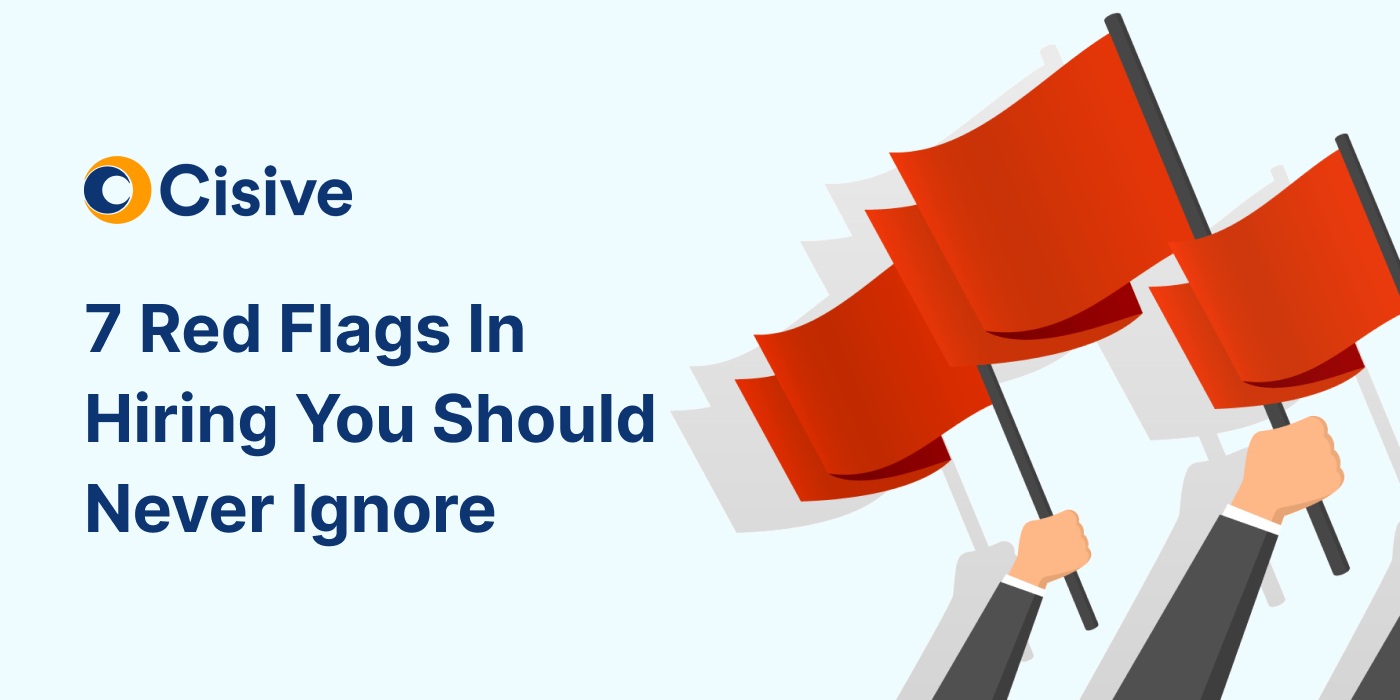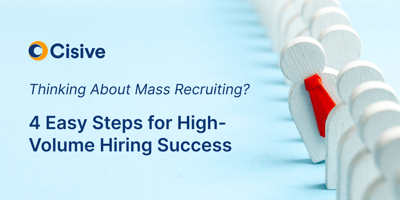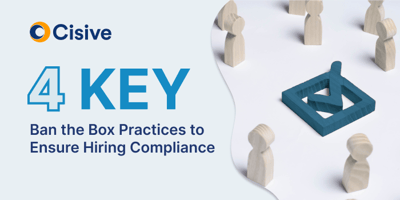

Enterprise organizations are often required to respond to changes in workforce and business...

It’s hard to measure the cost of a bad hire. You must factor in the money you spent hiring and training them, plus the cost of training someone else to replace them.
But having the wrong person in your team doesn’t just affect your bottom line. The impact of a bad hire can spread out and touch your clients, team, goals, and reputation.
Strong and effective hiring processes can help you avoid making a mistake during recruitment, preventing problems before they occur.
When businesses talk about a “bad hire,” they mean someone who doesn’t work within the company. This can be literal—they’re unable or unwilling to do the job they were hired to do—or it can be figurative, meaning they don’t fit into your culture or can’t work with your team.
The financial cost of a bad hire can be significant, although estimates of exact costs vary widely. A 2012 report from the Center for American Progress, used by the Department of Labor, found the average cost of turnover is 21% of the bad hire’s annual salary.
For someone earning the U.S. average of $59,000, this equates to $12,390. At the other end of the scale is an estimate from SHRM, which suggests that the cost of bad hires can run as high as $240,000.
The cost of a bad hiring decision includes finding and training a new employee. However, you also have to factor in the cost of lowered productivity while the new person gets up to speed.
Unfortunately, hiring the wrong person can cost more than just money. The consequences of a bad hire are often felt throughout your company.
Your relationship with your clients is one of the most important to your business. High-quality work that’s provided on time helps clients trust you and keeps them working with you.
A bad hire can jeopardize that trust. They may send your clients inferior work, miss deadlines, or not send it at all.
This will leave you scrambling to fix problems and give concessions to retain the client. In the worst-case scenario, your client may end up cutting ties with you altogether.
Poor client relations can impact your company’s overall reputation. Clients or customers who write bad reviews or tell others about their bad experiences could leave a stain on your brand image.
A bad hire can also affect your brand as an employer. If the person leaves a bad review on a site such as Glassdoor, you may find it hard to replace them.
In most workplaces, teams have to work together to reach goals. One person who isn’t pulling their weight can have a ripple effect across the whole business.
In some cases, a person who misses deadlines or provides poor work can stall other members of the team, delaying work for multiple people. Essentially, a bad hire can stop you from reaching your goals.
A bad apple on the team can spread resentment and apathy. You might be surprised at the damage it can do to team cohesion.
If others in the team see one person not working, they’re less motivated to complete their own tasks. On the other hand, they may be picking up the slack for the bad hire to ensure customers are satisfied and deadlines are met.
Either way, any irritation your team feels will spread past the bad hire. You can expect your team to start resenting you and others in your management team.
You also need to consider the time you or your managers spend supervising underperforming employees. One 2012 survey found that 17% of a manager’s time was spent on that task, and it’s likely that figure remains similar today.
Without that bad hiring decision, your time could be spent on tasks that actually make money for your company.
Hiring the wrong person impacts your recruitment process. There are both direct and indirect costs involved in hiring someone new.
Direct costs include the price of:
Indirect costs generally involve the time spent:
All this takes the people involved in recruitment away from their regular tasks.
Onboarding is also part of the recruitment process, and it’s wasted time if you train someone who doesn’t stay around. This can be especially concerning if you have proprietary systems or are developing a new product and want to protect your intellectual property.
While you’re going through this process, you’re also short a staff member. On average, it takes 44 days to fill a position, which means there are 44 days when your business isn’t working at full capacity.
It’s always best to prevent a problem, so you should avoid hiring the wrong person. That’s easier said than done, but the following seven signs of a bad hire may stop you from making a mistake.
Of course, it may be too late for prevention. If you’ve hired the wrong person, it’s better to catch it early, so you can start taking steps to fix the mistake.
These early warning signs can help you recognize when your new employee isn’t the right person for the job:
Thorough background checks and vetting processes can help you pick up on some of these issues. Accurate background screening can identify when people have falsified their education or employment history.
By talking to their references, you can also get an idea of how they perform in other workplaces and whether they actually have the skills they claim to possess.
Even if you’re recognizing the signs of a bad new hire, you may be able to salvage the situation. Taking proactive steps can help you manage the employee and decide on a course of action.
First, you should have regular performance reviews when a new person starts. These can be both formal and informal conversations.
This can let the staff member know what they’re getting right and wrong and also lets you take in feedback. If you talk to them about their experiences, you may find that something that can be easily fixed or explained is impacting their ability to work.
It’s likely you’ll have to consider whether to retrain or terminate a bad hire. Considering the cost and time involved in finding someone new, you may decide that retraining is a better option.
Talk to them about any aspect of the position they’re finding difficult. Additional training to cover any holes or clear up confusion may get them up to speed.
Don’t forget that there may also be legal considerations in terminating an employee. Documenting any discussions about their poor performance can help protect you from potential litigation costs for unfair dismissal.
Write a job description that’s detailed and accurately reflects the responsibilities, skills required, and expectations for the role. If you list requirements, such as overnight availability, the people unable to meet those demands are less likely to apply.
Find candidates who align with your values, mission, and culture. Consider the parts of your company’s culture that are the most important to fitting in, and base behavioral interview questions around these aspects.
Behavioral interview questions can focus on management styles, work-life balance, dream jobs, and employee motivation. Look for answers that match the environment you can provide.
Use platforms such as Cisive for background screenings that look at criminal history, employment history, and educational verification. This not only helps you hire a high-quality candidate, but it can also help protect you from liabilities caused by a bad hiring decision.
Streamline your interview processes to ensure there’s a consistent format for all candidates. This ensures everyone who’s interviewed is assessed for the attributes and areas of expertise you’re looking for.
Standardized tests or assignments can help you evaluate a candidate’s technical skills, problem-solving abilities, and cognitive aptitude. It also allows you to objectively compare candidates based on the results of the tests.
Diverse viewpoints can help teams cover blind spots and biases in interviews. If you involve a range of team members in the interview process, the multiple perspectives provided mean you’re more likely to get a well-rounded picture of each candidate.
Previous employers, colleagues, and other references can provide a good insight into how a candidate works, their past performance, and how they fit into a team. Don’t overlook this great resource when it’s time to assess potential employees.
A probationary period can be helpful to both you and your new employee. It allows you both to assess the employee’s fit and performance before either of you make a long-term commitment.
Your hiring managers should stay up-to-date on best recruitment practices, interview techniques, and unconscious bias awareness. This will help improve the overall recruitment process in your company, leading to higher-quality hires.
Ask your new hires about their recruitment experience. This provides valuable insights that can help you improve the company’s hiring processes.
An effective recruitment process is the best way to avoid a bad hire. Investing in training and tools for your hiring team can save you time and money in the long run.
Civise’s range of accurate background screening and compliance solutions are an essential part of your hiring toolbox. Contact Civise today to develop a program that helps you avoid bad hires.

Enterprise organizations are often required to respond to changes in workforce and business...

“Ban the box” laws have existed for more than 20 years and have taken effect across dozens of...

An employer’s ability to quickly onboard new employees can be beneficial for meeting customer...